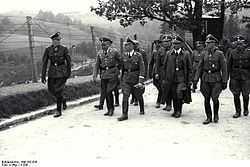Fritz Klingenberg
| Fritz Klingenberg | |
|---|---|
.jpg) Fritz Klingenberg | |
| Born |
17 December 1912 Rövershagen, Kingdom of Prussia |
| Died |
23 March 1945 (aged 32) Herxheim, Germany |
| Allegiance |
|
| Service/branch |
|
| Years of service | 1935–1945 |
| Rank | SS-Standartenführer |
| Unit |
2.SS-Division Das Reich 17.SS- Panzergrenadier-Division Götz von Berlichingen |
| Commands held |
17.SS- Panzergrenadier-Division Götz von Berlichingen SS-Junkerschule Bad Tölz |
| Battles/wars | World War II |
| Awards | Knight's Cross of the Iron Cross |
Fritz Klingenberg (17 December 1912 – 23 March 1945) was a German Waffen-SS officer who served with the 2.SS-Division Das Reich and was a commander of the 17.SS- Panzergrenadier-Division Götz von Berlichingen. He was best known for his unorthodox and audacious capture of the Yugoslavian capital, Belgrade for which he was awarded the Knight's Cross of the Iron Cross.
Early Life – Pre-War SS Service
Fritz Paul Heinrich Otto Klingenberg was a son of dairy owner and was born in Rövershagen in Mecklenburg on 17 December 1912. After successfully completing his high-school education, he began studying science and history at the University of Rostock. In 1934 however, he interrupted his university studies and joined the SS-Verfügungstruppe, becoming one of the first ever graduates of the new SS-Junkerschule at Bad Tölz. After his graduation he was assigned to SS-Standarte Germania, Das Reich and up until the outset of World War II, Klingenberg served on an inspection team of the SS-VT.
Götz von Berlichingen
On 21 December 1944, Fritz Klingenberg was promoted to SS-Standartenführer (Colonel) and two weeks later (on 12 January 1945) was ordered to take command of the 17. SS- Panzergrenadier-Division Götz von Berlichingen. The Division was attached to General Max Simon's XIII SS Corps, defending the area between Neustadt and Landau, southeast of Saarbrücken against the XV Corps of the U.S. Seventh Army. When resistance finally collapsed on 23 March 1945, Klingenberg was among the casualties. He was killed by a tank shell during a firefight between heavy 88mm FlaK and armored forces of the US-Army on the western edge of Herxheim and is buried at the German War Cemetery in Andilly, France.[1]
Personal

The consummate SS man, Klingenberg was fairly tall, standing over 6 feet 4 inches (1.93 m). A photograph taken at Klingenberg's Knight's Cross presentation ceremony at the Berghof in 1941 shows him standing with Hitler. Klingenberg was apparently tall enough that, according to an aide to photographer Heinrich Hoffmann, Klingenberg was asked by Hoffmann to stand to the side and slightly behind Hitler so as to not dwarf the Führer, who stood about 5 feet 9 inches (1.75 m). The disparity, however, can still be clearly seen in the photograph.
Summary of SS career
Dates of rank
- SS-Untersturmführer: 20 April 1935
- SS-Obersturmführer: 12 December 1937
- SS-Hauptsturmführer: 30 June 1939
- SS-Sturmbannführer: 1 September 1941
- SS-Obersturmbannführer: 21 December 1943
- SS-Standartenführer: 21 December 1944
Notable decorations
- German Cross in Gold (1944)
- Eastern Front Medal (1942)
- Iron Cross Second (1940) and First (1940) Classes
- SS-Honour Ring (?)
- Sudetenland Medal (?)
- Anschluss Medal (?)
- Knight's Cross of the Iron Cross (1941)
- Wound Badge in Black (?)
- Infantry Assault Badge(?)
References
- Citations
- ↑ Günther 1991, p. 168.
- Bibliography
- SS-Das Reich: The History of the Second SS Division, 1941–1945 by Gregory L. Mattson (Zenith Press, (22 March 2002), ISBN 0-7603-1255-9, ISBN 978-0-7603-1255-1).
- The SS: Hitler's Instrument of Terror: The Full Story From Street Fighters to the Waffen-SS by Gordon Williamson (Motorbooks International, (March 1994), ISBN 0-87938-905-2, ISBN 978-0-87938-905-5).
- Invasion of Yugoslavia: Waffen SS Captain Fritz Klingenberg and the Capture of Belgrade During World War II by Colin D. Heaton
- Patzwall, Klaus D.; Scherzer, Veit (2001). Das Deutsche Kreuz 1941 – 1945 Geschichte und Inhaber Band II [The German Cross 1941 – 1945 History and Recipients Volume 2] (in German). Norderstedt, Germany: Verlag Klaus D. Patzwall. ISBN 978-3-931533-45-8.
- Die Sturmflut und das Ende – Band 3, Mit dem Rücken zur Wand – Geschichte der 17.SS-Panzergrenadierdivision "Götz von Berlichingen" by Helmut Günther (Schild Verlag, (1991), ISBN 3-88014-103-7).